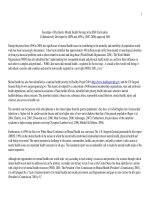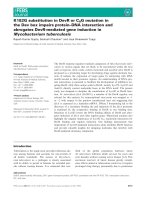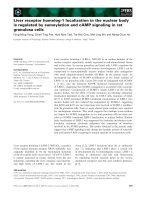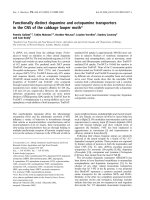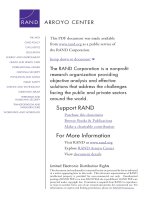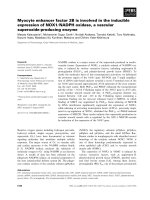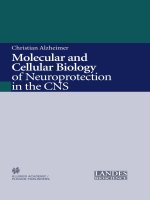Sirtuin2 in the CNS expression, functional roles, action mechanism and mutation induced alteration of molecular cell biological properties
Bạn đang xem bản rút gọn của tài liệu. Xem và tải ngay bản đầy đủ của tài liệu tại đây (4.83 MB, 180 trang )
SIRTUIN 2 IN THE CNS: EXPRESSION, FUNCTIONAL
ROLES, ACTION MECHANISM AND MUTATION-INDUCED
ALTERATION OF MOLECULAR/CELL BIOLOGICAL
PROPERTIES
LI WENBO
(B.Sc., Zhejiang University, Hangzhou, China)
A THESIS SUBMITTED
FOR THE DEGREE OF DOCTOR OF PHILOSOPHY
DEPARTMENT OF ANATOMY
YONG LOO LIN SCHOOL OF MEDICINE
NATIONAL UNIVERSITY OF SINGAPORE
2008
Acknowledgements
ACKNOWLEDGEMENTS
I sincerely thank Associate Professor Liang Fengyi, Department of Anatomy,
Yong Loo Lin School of Medicine, National University of Singapore (NUS), for his
critical supervision and active support during my PhD study. His insights in grasping
the best direction of projects, originality in analyzing the experimental data and
dedication to scientific research impressed me and will surely benefit my future
endeavors.
I am also grateful to my co-supervisor Associate Professor Xiao Zhicheng and
Dr. Hu Qidong, Department of Clinical Research, Singapore General Hospital, for
valuable discussions about my projects and kind support in providing cell culture
materials and techniques.
My special appreciation is to Professor Ling Eng Ang for his insights into the
significance of research projects and his encouragement from time to time.
My sincere acknowledgement and gratitude are also devoted to those colleagues
in our research group that I have worked with and benefited from: Dr. Zhang Bin, Dr.
Tang Junhong, Dr. Cao Qiong, Dr. Guo Anchen, Ms. Wu Chun, Ms. Guo Jing, Mr. Xia
Wenhao, Mr. Meng Jun, Ms. Tang Jing, Dr. Tran Manh Hung, Ms. Luo Xuan and Ms.
Pooneh Memar Ardestani.
I wish to thank Ms. Chan Yee Gek and Ms. Wu Ya Jun who provided perfect
support in the confocal and electron microscopy studies. I am also grateful to Ms. Ng
Geok Lan and Ms. Yong Eng Siang for their technical assistance; to Mdm Ang Lye
Gek Carolyne, Mdm Teo Li Ching Violet and Mdm Diljit Kour d/o Bachan Singh for
i
Acknowledgements
their assistance.
I would like to express my gratitude to all the colleagues, students and staff
members of Department of Anatomy, Yong Loo Lin School of Medicine for their
generous help. In particular, I would like to thank Dr. Guo Chunhua for his
accompaniment and sharing of research and life experiences; I am also grateful to Ms.
Loh Wan Ting for her kind help in research work and providing experimental
materials; furthermore, the thankfulness is given to Mr. Feng Luo, Mr. Guo Kun and
Mr. Jiang Boran for instructions on facility using as well as help in my experiments.
I would like to thank NUS for granting me graduate student scholarship and
president’s graduate fellowship to support my life and study in Singapore. This work
was supported by research grants from Singapore Biomedical Research Council
(BMRC/01/1/21/19/179 04/1/21/19/305 and 06/1/21/19/460) and National Medical
Research Council (0946/2005) (to A/P Liang FY).
Finally, I must always be grateful to my parents and sister, who are my support
for study and life at all times, whose love and support accompanied me during the
up-and-downs in my 23 years of life as a student. This thesis for PhD degree would be
dedicated to them.
ii
Table of contents
TABLE OF CONTENTS
ACKNOWLEDGEMENTS i
TABLE OF CONTENTS iii
LIST OF TABLES AND FIGURES viii
LIST OF ABBREVIATIONS xi
LIST OF PUBLICATIONS xv
SUMMARY xvii
CHAPTER 1 INTRODUCTION 1
1. Oligodendrocytes in the CNS 2
1.1 Cell types in the nervous system 2
1.2 Oligodendrocytes 4
1.2.1 Differentiation of oligodendrocytes 4
1.2.2 Molecules and mechanisms control oligodendrocyte development 7
1.3 Myelination 11
1.3.1 Myelination and myelin 11
1.3.2 The polarized myelin sheath in morphology 13
1.3.3 The chemical composition of myelin sheath 16
2. Histone deacetylase 17
2.1 Histone deacetylation: an important modification of histones 17
2.2 Histone deacetylase family proteins 20
2.2.1 Class I HDACs 21
iii
Table of contents
2.2.2 Class II HDACs 22
2.2.3 Class III HDACs: SIR2 family of proteins 24
2.2.3.1 SIR2 in lower animals and mammalian Sirtuins 24
2.2.3.2 The biochemistry of SIR2 and Sirtuins 26
2.2.3.3 Biological functions of Sirtuins 27
2.3 Involvement of HDACs and Sirtuins in nervous system functions 34
3. Protein mutations and cellular aggregates 36
3.1 Abnormal aggregation of proteins in CNS diseases 36
3.2 Specific protein mutations and aggregates 37
3.3 Aggregates in their two appearances 38
3.4 Aggresomes 39
3.5 The mechanisms behind protein aggregation 40
3.6 Consequences of protein aggregation 41
4. The objectives of the current study 42
CHAPTER 2 MATERIALS AND METHODS 44
1. Chemicals 45
2. Experimental animals 46
3. Cloning, in vitro expression of rat SIRT2 46
4. Mutagenesis and construction of sirt2 variants/polymorphisms 48
5. siRNA knockdown 51
6. Antibodies 51
iv
Table of contents
7. Cell culture 53
8. Transfection of cells 54
9. Western blotting 55
10. Immunoprecipitation and in vitro tubulin deacetylase assay 55
11. Solubility test of SIRT2 mutants 56
12. In situ hybridization histochemistry 57
13. Immunofluorescent double/triple labeling 58
14. Immunocytochemistry and transmission electron microscopy 58
15. Data analyses 60
CHAPTER 3 RESULTS 62
1. The generation of rabbit polyclonal anti-SIRT2 antibody 63
1.1 Expression of recombinant GST-SIRT2c protein 63
1.2 Specificity test of the antibody 63
2. SIRT2 was expressed predominantly in rat CNS 65
3. Postnatal SIRT2 expression level co-fluctuated with that of CNP 66
4. SIRT2 was a protein mainly found in oligodendroglia and myelin 67
4.1 In situ hybridization histochemistry (ISH) 67
4.2 Immunohistochemistry (IHC) 69
4.3 Immunofluorescent double labeling 70
5. SIRT2 was localized to juxtanodal area in the myelin sheath 73
6. SIRT2 NAD-dependently deacetylated α-tubulin 75
v
Table of contents
7. Association among SIRT2 expression, α-tubulin acetylation levels
and oligodendrocyte maturation in culture 80
8. SIRT2 overexpression lowered α-tubulin acetylation levels and inhibited
OLP differentiation 82
9. Knockdown of endogenous SIRT2 by siRNA promoted α-tubulin acetylation
and accelerates OLP differentiation 87
10. Overexpression of specific SIRT2 mutants triggered aggregates formation
in cultured cells 91
11. Mutated SIRT2 clumps deformed Golgi apparatus and coaggregated
with endogenous cellular molecules 95
12. Cytoplasmic aggregates were not induced by the loss of rSIRT2
deacetylase activity 99
13. Solubility decrease contributed to aggregate formation by rSIRT2 mutants 100
14. A protective role of the N-terminus domain of human SIRT2 against
solubility loss and aggregation 103
15. Microtubule and HDAC6 functions affected the aggregate formation
induced by SIRT2 mutants 108
CHAPTER 4 DISCUSSION 111
1. SIRT2 as a protein preferentially expressed in oligodendrocytes 112
2. SIRT2 as a differentiation inhibitor of oligodendrocytes 112
3. SIRT2 expression, tubulin deacetylation and oligodendroglial differentiation 114
vi
Table of contents
4. Overexpression of mutated forms of rSIRT2 differentially induced
aggregate formation 116
5. Deacetylase activity loss is not the cause of aggregate formation 117
6. Determinant of aggregate formation 118
6.1 Insolubility, cytoplasmic aggregate formation and cytotoxicity of
rSIRT2 mutants 118
6.2 Factors in addition to solubility decrease contributed to
rSIRT2 mutation-induced aggregates formation 121
7. The extra N-terminal domain endows hSIRT2 protection from
mutation-induced insolubility and aggregation 123
8. SIRT2, brain aging and neurodegeneration? 126
CHAPTER 5 CONCLUSIONS AND FUTURE STUDIES 128
1. Conclusions 129
2. Future studies 130
REFERENCES 133
vii
List of tables and figures
Tables
Table 1.1 Typical gene expression in each oligodendrocyte
differentiation stage 6
Table 1.2 Summary of histone deacetylases 33
Table 2.1 Primers used for cloning and in vitro expression 48
Table 2.2 Point mutations of human and rat Sirt2 in the current study 50
Table 2.3 siRNAs used in the current knockdown experiments 51
Figures
Figure 1.1 Oligodendrocytes differentiate in morphology 6
Figure 1.2 Periodic structure of myelin sheath 13
Figure 1.3 Axons myelinated by oligodendrocytes in the CNS 14
Figure 2.1 Flow chart of the methodology used in this study 45
Figure 3.1 Molecular features of rat SIRT2 protein 64
Figure 3.2 Distribution of rat SIRT2 protein in different tissues 65
Figure 3.3 Developmental expression of SIRT2 protein in rat CNS 66
Figure 3.4 Distribution of SIRT2 mRNA in rat CNS 68
Figure 3.5 Distribution of SIRT2 protein in rat CNS 69
Figure 3.6 SIRT2 is predominantly an oligodendroglial protein 72
Figure 3.7 SIRT2 localizes in the juxtanodal region adjacent to
nodes of Ranvier 73
Figure 3.8 SIRT2 localization in oligodendrocytes and myelin
sheaths under electron microscope 74
viii
List of tables and figures
Figure 3.9 SIRT2 is an NAD-dependent histone deacetylase with as
α-tubulin its preferable substrate 77
Figure 3.10 Overexpressed SIRT2 deacetylates α-tubulin in OLN-93 cells 79
Figure 3.11 Cofluctuation between the morphological complexity of
primary OLPs, the acetylation levels of α-tubulin and
expression of SIRT2 and CNP 81
Figure 3.12 Overexpression of SIRT2 inhibits the morphological
differentiation of primary OLPs 84
Figure 3.13 Overexpressed SIRT2 counteracts the promotive effects of
JN on cell arborization in OLN-93 cells 86
Figure 3.14 Knockdown of endogenous SIRT2 in primary OLPs in early
stages of cell differentiation 88
Figure 3.15 Prolonged knockdown of endogenous SIRT2 expression
promotes differentiation of primary OLPs 90
Figure 3.16 Schematic diagram showing the mutated residues of rSIRT2
and hSIRT2 in the current study 91
Figure 3.17 Overexpression of specific mutants of rSIRT2 induces cellular
aggregates in primary OLPs 92
Figure 3.18 Cellular aggregates triggered in 293T and OLN-93 cells
by overexpression of specific SIRT2 mutants 94
Figure 3.19 The aggregates induced by mutated rSIRT2
overexpression contain ubiquitinated proteins 96
ix
List of tables and figures
Figure 3.20 rSIRT2 mutant-induced aggregation is not resulted from loss
of deacetylase activity 99
Figure 3.21 Decreased solubility may contribute to aggregate formation
by SIRT2 mutants 101
Figure 3.22 An inverse correlation between aggregate-triggering propensity
and protein solubility of mutants 102
Figure 3.23 Upon overexpression, hSIRT2 mutants showed solubility
decrease but did not cause aggregate formation 104
Figure 3.24 Schematic diagram showing four different kinds of human, rat
or human-rat chimera SIRT2 used in this study 105
Figure 3.25 Protection of hSIRT2 N-terminus domain against solubility loss
and protein aggregation 107
Figure 3.26 Stability of microtubule network influences the formation
of aggregations but not protein solubility 109
Figure 3.27 HDAC6 is required for the formation of aggregates
triggered by rSIRT2 mutants 110
Figure 5.1 Summary of the conclusions reached in this study 130
Figure 5.2 A diagram showing the functions and pathways related
to SIRT2 132
x
List of abbreviations
LIST OF ABBREVIATIONS
Ab antibody
ABC avidin-biotin complex
AD Alzheimer’s disease
ALS amyotrophic lateral sclerosis
AP alkaline phosphate
BCIP 5-bromo-4-chloro-3´-indolylphosphate
bFGF bovine fibroblast growth factor
bp base pair
BSA bovine serum albumin
CBD corticobasal degeneration
cDNA complementary DNA
CNP 2’, 3’-cyclic nucleotide-3’-phosphodiesterase
CNS central nervous system
CR calorie restriction
cRNA complementary RNA
DAB 3. 3’-diaminobenzidine tetrahydrochloride
DAPI 4’,6-diamidino-2-phenylindole
DMEM dulbecco’s modified Eagle’s medium
DMSO dimethyl sulfoxide
DNA deoxyribonucleic acid
DTT dithiothreitol
xi
List of abbreviations
EDTA ethylenediaminetetraacetic acid
EGFP enhanced green fluorescent protein
EM electron microsopy
FBS fetal bovine serum
FOXO Forkhead box class O
FTDP-17 frontotemporal dementias with Parkinsonism linked to
chromosome 17
GD3 Ganglioside GD3
GFAP glial fibrillary acidic protein
HA hemagglutinin
HAT histone acetyltransferases
HD Huntington's disease
HDAC histone deacetylase
HEPES 4-(2-Hydroxyethyl) piperazine-1-ethanesulfonic acid
HIC1 hypermethylated in cancer 1
HMG high-mobility-group family proteins
HMSN inherited motor and sensory neuropathies
hNter the 37-residue N terminus domain of hSIRT2
ICC immunocytochemistry
IHC immunohistochemistry
IPTG isopropyl-1-thio-β-D-galactopyranoside
JN juxtanodin
xii
List of abbreviations
kDa kilodalton
mAb monocolonal antibody
MAG myelin associated glycoprotein
MBP myelin basic protein
MOG myelin-oligodendrocyte glycoprotein
MS multiple sclerosis
MW molecular weight
mRNA messager RNA
NAD nicotinamide
NAM nicotinamide adenine dinucleotide
NBT nitro-blue tetrazolium
NDAC NAD-dependent deacetylase
NF neurofilament
NP-40 nonidet P-40
NGS normal goat serum
OLP primary cultured oligodendrocyte precursor cells
ORF open reading frame
pAb polyclonal antibody
PBS phosphate buffered saline
PCR polymerase chain reaction
PD Parkinson’s disease
PDGF platelet-derived growth factor
xiii
List of abbreviations
PDL poly-D-lysine
PLP proteolipid protein
PML4 promyelocytic leukemia protein 4
PSP progressive supranuclear palsy
PVDF polyvinylidene diluoride
RNA ribonucleic acid
RPD potassium dependency protein
RT room temperature
SDS-PAGE sodium dodecyl sulphate polyacrylamide gel electrophoresis
SNP single nucleotide polymorphisms
siRNA small interference RNA
SIR2 Silent information regulator-2
T3 triiodothyronine
T4 thyroxine
TBS tris buffered saline
TEMED N,N,N’N’-tetramethylethylene diamine
Tris 2-amino-2-(hydroxymethyl)-1,3-propanediol
TSA Trichostatin A
WB Western blotting
X-gal 5-Bromo-4-chloro-3-indoyl-β-D-galactopyranoside
xiv
List of publications
LIST OF PUBLICATIONS
Articles
1. Li W, Zhang B, Tang J, Cao Q, Wu Y, Wu C, Guo J, Ling EA, Liang F. Sirtuin 2,
a mammalian homolog of yeast silent information regulator-2 longevity regulator,
is an oligodendroglial protein that decelerates cell differentiation through
deacetylating alpha-tubulin. The Journal of Neuroscience. 2007, 7
th
March;
27(10):2606-16
2. Liang F, Zhang B, Tang J, Guo J, Li W, Ling EA, Chu H, Wu Y, Chan YG, Cao Q.
RIM3gamma is a postsynaptic protein in the rat central nervous system. Journal
of Comparative Neurology. 2007, 1
st
August; 503(4):501-10
3. Li W, Tang J, Ling EA, Zhang B, Liang F. Solubility loss-dependent cytoplasmic
aggregation of SIRT2 mutants/variants, and the protective effect of human SIRT2
N-terminus. (Submitted)
Abstracts for conferences
1. Li W, Liang F. Specific Sirtuin-2 mutations trigger aggregate formation and
reduce solubility of the protein when overexpressed in cultured cells. Proceedings
of the SFN 37
th
Annual Meeting, 3-7th November, 2007, San Diego, California,
USA
2. Liang F, Tang J, Li W. Developmental expression of Sirtuin-2 in the rat CNS.
Proceedings of the SFN 37
th
Annual Meeting. 3-7th November, 2007, San Diego,
California, USA
xv
List of publications
3. Li W, Liang F. Overexpression of specifically mutated forms of SIRT2 triggers
aggregates formation. Annual Meeting for Singapore Microscopy Society. 20th April
2007, Singapore
4. Liang F, Zhang B, Tang J, Guo A, Li W, Cao Q. Developmental expression of
juxtanodin in the rat CNS. Proceedings of the SFN 35
th
Annual Meeting. 12-16th
November, 2005, Washington, D.C., USA
xvi
Summary
Oligodendrocytes, the myelin-forming cells in the Central Nervous System (CNS)
of vertebrates, mature through a highly regulated but precisely timed differentiation
process. The mechanisms underlying this differentiation process are under extensive
investigations in the past decades.
Silent information regulator-2 (SIR2) proteins regulate lifespan of diverse
organisms. In mammals, SIR2 are represented by seven members SIRT1-7, which are
also collectively called Sirtuins. In the nervous system, though implicated to be
important by many evidences, Sirtuins are still largely mysterious in their expression
patterns, functional roles and action mechanisms. In addition, polymorphisms or
mutations of Sirtuins are well documented, but the significance of these variations for
health and diseases of the host cell or organism is essentially unknown.
The current study, on the first hand, shows that Sirtuin 2 (SIRT2) is an
oligodendroglial cytoplasmic protein enriched in the outer and juxtanodal terminal
loops in the myelin sheath. Among cytoplasmic proteins of OLN-93 oligodendrocytes,
α-tubulin was the main substrate of SIRT2 deacetylation. In cultured primary
oligodendrocyte precursors (OLPs), SIRT2 emergence accompanied elevated
α-tubulin acetylation and OLP differentiation into the pre-maturity stage. siRNA
knockdown of SIRT2 increased OLPs’ α-tubulin acetylation, myelin basic protein
(MBP) expression and cell arbor complexity. SIRT2 overexpression had opposite
effects, and counteracted the cell arborization-promoting effects of overexpressed
juxtanodin (JN). Specific SIRT2 mutations concomitantly reduced its deacetylase
activity and inhibition on OLP arborization.
xvii
Summary
On the other hand, our study showed that overexpression of specific rSIRT2
mutants induced formation of prominent cytoplasmic aggregates containing both the
mutated rSIRT2 and native cellular proteins including 2’, 3’-cyclic
nucleotide-3’-phosphodiesterase (CNP) and ubiquitin. But deacetylase activity loss
could not account for the aggregate formation because siRNA knockdown of
endogenous rSIRT2 did not replicate similar phenomenon, nor did overexpression of
some enzymatically defective rSIRT2 mutants. By contrast, the current study
identified solubility decrease as a direct result of SIRT2 mutations, which are
inversely correlated to the aggregate formation propensities of rSIRT2 mutant proteins.
Stabilization of the microtubule network or knockdown of innate histone deacetylase
6 (in 293T cells) reduced the number of aggregate-positive cells caused by rSIRT2
mutants. Furthermore, the results showed that a unique 37-residue N terminus domain
of hSIRT2 (hNter) endowed mutated hSIRT2 or rSIRT2 a protection from solubility
loss and aggregation; this domain also inhibits the solubility decreases after mutation.
These results firstly demonstrated a counterbalancing role of SIRT2 against a
facilitatory effect of tubulin acetylation on oligodendroglial differentiation. Secondly,
these results suggested contribution of solubility decrease to aggregate formation or
cytotoxicity of specific SIRT2 mutants. Also, the 37aa hNter domain may be a crucial
evolutionary improvement from rat to human, enhancing normal protein solubility and
function. It calls for further investigations to test the role of SIRT2 in myelinogenesis,
oligodendroglial differentiation and myelin-axon interaction. Future studies will also
be necessary and important to understand Sirtuins’ polymorphisms and mutations in
xviii
Summary
the context of brain aging, neurodegenerative diseases and dys- or demyelination as
well as the exact role of hNter domain in relation to evolution.
xix
Introduction
CHAPTER 1
INTRODUCTION
1
Introduction
1. Oligodendrocytes in the central nervous system
1.1 Cell types in the nervous system
The nervous system can be divided into Central Nervous System (CNS) or
Peripheral Nervous System (PNS) based on their distinctiveness in anatomical
distribution and function. Both at the cellular level consist of nerve cells (neurons)
and glial cells (glia). Neurons are the main signaling units of the nervous system, and
typically defined by four morphologically distinct regions: the nerve cell body, the
axons, the dendrites and presynaptic terminals. Each of these four regions bears
distinctly different functions in the generation and maintenance of information
communication in the nervous system. Among these four regions, axons are
specialized branches extending from neurons, which are long and tubular processes
acting like antennas to convey signals to target cells. When neurons need to transmit
signals, electrical signals have to be generated and propagated through axons. These
electrical signals called action potentials are usually rapid, transient, all-or-none nerve
pulse.
The other main class of cells in nervous system is glia. Firstly described by
Virchow in 1846, gial cells were classically thought to be the connective tissue of
brain at that time. They represent a large majority of cells in nervous system and
greatly outnumber neurons by 10 to 50 times in vertebrate CNS. In addition to
traditional supportive roles, findings in recent years have demonstrated the active
participation of gila in the physiology of the brain and the adverse consequences of
their dysfunction (Baumann and Pham-Dinh, 2001). There are four main glial cell
2
Introduction
types in the nervous system: astrocytes, microglia, oligodendrocytes and Schwann
cells. As the most numerous glial cells, astrocytes are largely supportive cells in the
nervous system that are star-shaped and bear long processes. These cells may play
roles in nourishing neurons, and some astrocytes can employ the endothelial cells of
blood vessel to form tight junctions, creating the protective blood brain barrier in
between blood and brain. Meanwhile, astrocytes can help to maintain or regulate
concentrations of some ions or transmitters to protect neurons and guarantee normal
neuronal functions (Kandel et al., 2001). Microglias are phagocytic cells residing in
the nervous system, which can be activated after injury, infection or disease. Though
these cells function in nervous system, it is still debated as whether microglias are
physiologically and embryologically related to the other cell types of the nervous
system because they arise from macrophages outside. Upon activation, microglia will
extend processes stouter and more branched and may serve as antigen presenting cells
in the nervous system. They are proposed to be activated in a series of diseases
ranging from multiple sclerosis (MS) to Parkinson’s disease (PD) and Alzheimer’s
disease (AD) (Kandel et al., 2001).
Oligodendrocytes and Schwann cells are two types of insulating cells, which
function in different parts of nervous system. Oligodendrocytes exist in CNS whereas
Schwann cells occur in PNS. Both of them work to wrap around axons in a spiral with
their extended and specialized membranous processes. These processes around axons
are called myelin sheath and this insulation process was named myelination (Kandel
et al., 2001). By myelination, nerve impulses generated in excited neurons propagate
3
Introduction
more rapidly along the shaft of myelinated axons.
1.2 Oligodendrocytes
Oligodendrocytes are specialized cells to fulfill the myelination function in the
CNS. The term oligodendrocytes, or its interchangeable synonym oligodendroglia that
was named by Rio Hortega (Hortega, 1921), are initially used to describe cells in the
CNS that show few processes in material stained by metallic impregnation techniques.
Oligodendrocytes are generated from multipotent neuroepithelial cells (Chandran et
al., 1998), and their specialized myelin-forming function was endowed by a precisely
regulated differentiation process. Along lineage progression, the sequential and timed
expression of developmental regulators as well as gradual morphological
differentiation divides the whole lineage into several distinct genotypic and
phenotypic stages (Baumann and Pham-Dinh, 2001).
1.2.1 Differentiation of oligodendrocytes
The end-point of oligodendrocyte differentiation is to be functionally complete
cells to form myelin sheaths around multiple axons that facilitates saltatory nerve
conductions (Baumann and Pham-Dinh, 2001; Franklin, 2002). Oligodendrocytes
experienced several distinct stages of differentiation till maturation in order to
produce all the specific constituents of myelin sheaths and fulfill the myelination
function. These stages can be generally divided into precursors, pre-oligodendrocytes,
pre-maturity oligodendrocytes (immature oligodendrocytes), non-myelinating mature
4
Introduction
oligodendrocytes and myelinating mature oligodendrocytes. Different stages are
characterized by different proliferative capacities, migratory abilities and
morphologies (Barry et al., 1996; Baumann and Pham-Dinh, 2001). The progression
from precursors to myelinating oligodendrocyte entails a sequence of events,
including cell cycle exit, cytoskeletal changes and synthesis of myelin components.
On the one hand, oligodendrocytes undergo striking changes in shapes during
lineage progression. They develop from mono- or bipolar to multipolar morphology
as shown in Figure 1.1. The eventual outcome is that the myelinating
oligodendrocytes appear to be highly branched and complex (sometimes with wooly
or hairy fine processes or even form lamellipodia structure) that they are able to
extend their membranes to complete the myelination by wrapping around axons
(Pfeiffer et al., 1993). On the other hand, a series of molecules are sequentially
expressed in a timed fashion. The precursors of oligodendrocytes originated from
distinct locations of CNS during late embryonic development. These cells can be
stained by the monoclonal antibody (mAb) A2B5, which recognizes several
gangliosides (Eisenbarth et al., 1979; Fredman et al., 1984). A2B5 immunoreactivity
was accompanied by the expression of platelet-derived growth factor receptor α
(PDGFRα, Hall et al., 1996). The mRNA of DM-20 coding a PLP (proteolipid protein)
isoform can also be detected in this stage (Timsit et al., 1995). Some other markers are
also used to observe early stage oligodendrocytes, such as NG2 proteoglycan
(Nishiyama et al., 1996). When the cells further differentiate, they enter the second
stage—pre-oligodendrocytes. The gene expressions in these cells are significantly
5
